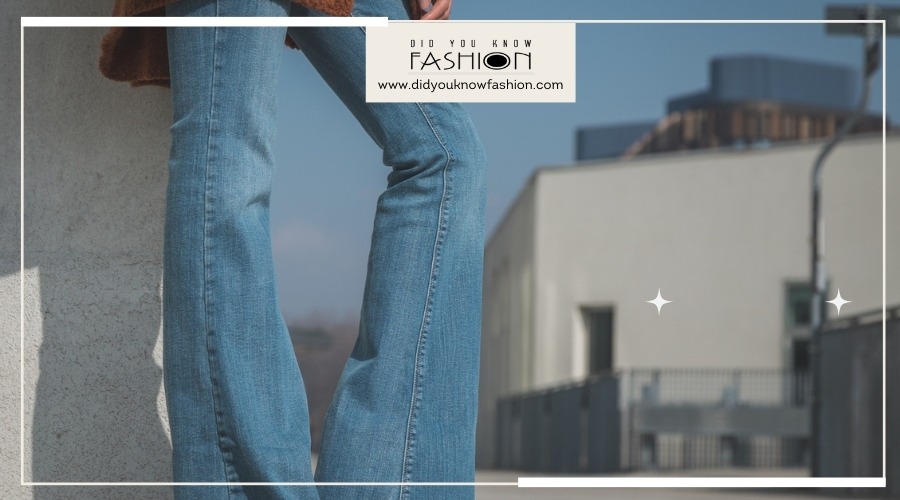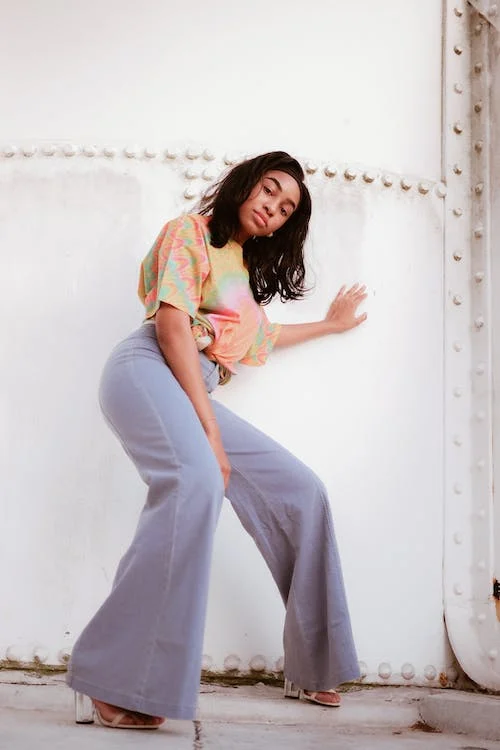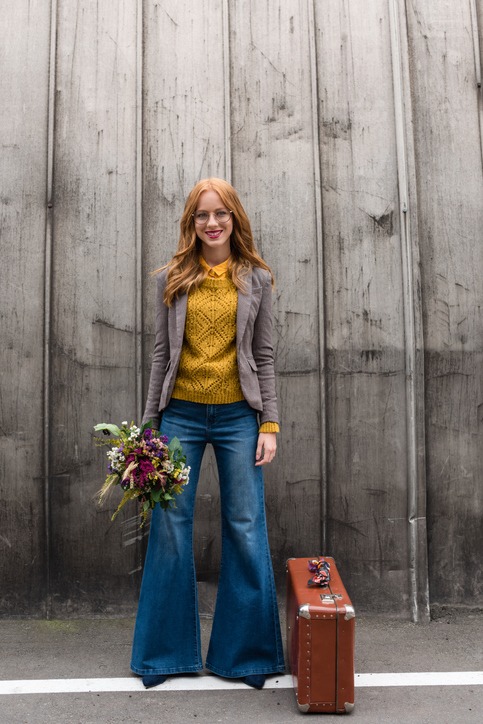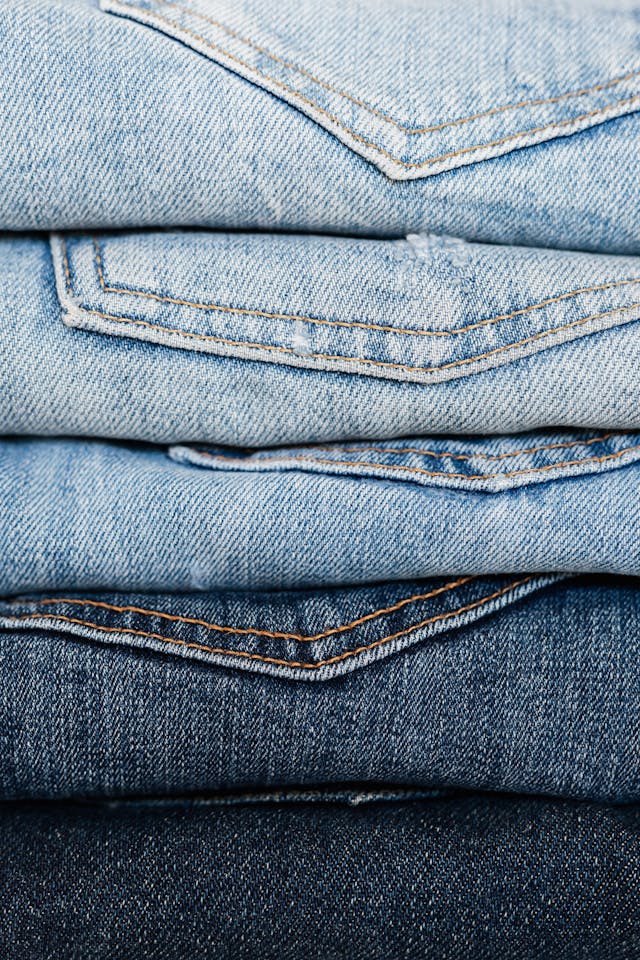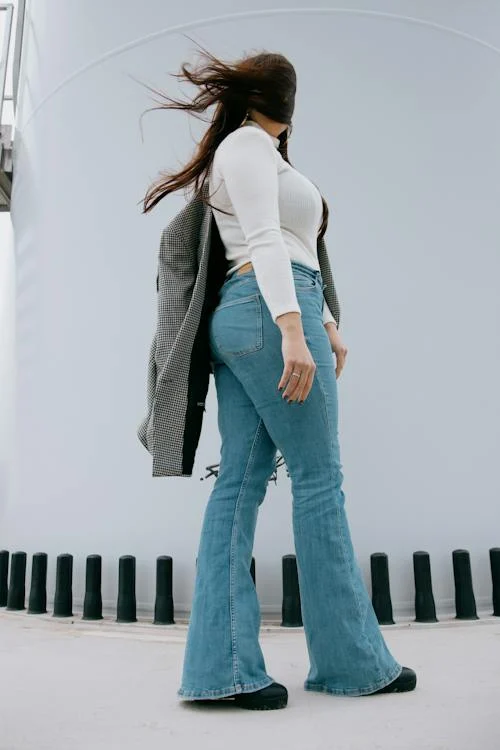Bell-bottom jeans emerged as a defining fashion trend in the 1960s, originally gaining popularity within the youth cultures of London before spreading across Europe and North America. Characterized by their distinctive flare from the knee downward, they became a symbol of self-expression and nonconformity during an era marked by social upheaval and cultural change. Typically fashioned from denim, the versatile fabric of the working class, bell-bottoms transcended their utilitarian roots to become a staple of fashionable wardrobes, with the width of the leg opening reaching up to 18 inches, creating an unmistakable silhouette against the more conservative styles of previous decades.
The adoption of the bell-bottom design was significant during the counterculture movement, as young people sought to challenge the status quo through various means, including their wardrobe choices. The flare style of the jeans represented a break from traditional fashion norms, and they were often customized with elements such as unfinished hems, patchwork, and vibrant embroidery, all of which contributed to the personalized aesthetic of the time. This customization was not just about fashion; it was an act of personal and political expression.
The prominence of bell-bottom jeans endured throughout the decade and into the 1970s, with variations like bootcut jeans playing a role in the broader fashion movement that embraced flares. While men’s fashion incorporated bell-bottoms in several forms, from denim to more vibrant and patterned materials, the style was unisex, with both men and women incorporating bell-bottom jeans into their ensembles. This period of fashion is often revisited for its boldness and creativity, underlining its lasting impact on the way people dress and express themselves.
Cultural and Fashion Significance
Bell-bottom jeans emerged as a significant cultural and fashion trend in the 1960s, embodying the spirit of self-expression and freedom associated with the decade. They became a symbol of counterculture and a unisex trend worn by both men and women.
Rise of Bell-Bottom Jeans
In the 1960s, bell-bottom jeans gained popularity primarily among the youth, particularly those who identified with the hippie movement. These trousers were characterized by their distinctive flare from the knee downwards, which set them apart from conventional straight-legged pants of the time. Originally used by sailors for their functionality, bell-bottoms were adopted by hippies who embraced them for their unique aesthetic and as a rejection of mainstream fashion norms. Bell-bottoms represented a break from tradition and became a form of sartorial self-expression that aligned with other symbols of the era, such as peace signs.
Key Features of Bell-Bottom Jeans in the 60s:
- Symbolism: Represented rebellion and freedom.
- Material: Predominantly made of denim, although other fabrics were used.
- Unisex Appeal: Worn by both men and women.
- Associated Movements: Linked to the hippie and anti-establishment movements.
Influence on Subsequent Decades
Bell-bottom jeans not only defined the 60s fashion but also had a lasting influence on subsequent decades. They paved the way for a variety of flared styles, including the more subdued boot-cut of the 1990s and 2000s which offered a less exaggerated flare. The essence of bell-bottoms, encapsulated by their bold flare and associations with freethinking, resurfaced over time, with their aesthetic being revisited in various revival trends. This cyclical nature of fashion ensured that bell-bottoms remained relevant as an iconic design that continued to inspire new generations seeking to channel the spirit of the ’60s.
Design and Aesthetic Characteristics
The design of bell-bottom jeans in the 1960s epitomized a blend of functionality and a pronounced fashion statement that evolved distinctly over the decade.
Evolution of Bell-Bottom Design
Bell-bottom pants initially served practical purposes for sailors needing to roll up their trousers, before transitioning into a symbol of self-expression during the 1960s. They became associated with the counter-culture movement, reflecting a breakaway from conventional styles. Designers incorporated various materials like denim, corduroy, and polyester to cater to different tastes and seasons. Throughout the decade, the bell-bottom pant continuously widened from the knee downwards, with some designs boasting a circumference up to 18 inches at the leg opening by the end of the 1970s.
Distinctive Features and Variations
Bell-bottom jeans are characterized by their tapered leg design that dramatically flares out from the knee to the hem, forming a bell-like shape. The wide bell bottom was particularly popular among youth, often embellished with:
- Embroidery
- Stripes
- Loud prints including paisley
Materials like denim provided durability and ease of wear, while polyester offered a shinier, dressier look. Cotton versions made bell-bottoms accessible and comfortable. Design variations included:
- Solid colors for a more subdued expression
- Paisley and other loud prints for bold, individualistic looks
Fashion enthusiasts often personalized their bell-bottoms with patches and other DIY modifications, emphasizing the pant’s role as a canvas for personal style.
Production and Manufacturing Techniques
The production of bell-bottom jeans in the 1960s revolved around specific materials and tailoring innovations that were distinct to the era. These aspects contributed to the unique aesthetic and cultural significance of the garment.
Materials and Fabrics
Bell-bottom jeans of the 1960s were typically made of denim, a durable, cotton twill fabric that was well-suited for casual wear and could withstand the rigors of the counterculture lifestyle. Corduroy, another popular material, offered a distinctive texture and was often used as an alternative to denim. It provided warmth and was available in various colors, thus adding to the vibrant palette of ’60s fashion. Occasionally, different blends featuring polyester or wool were also used, catering to different preferences and climates.
Fabrics used in production:
- Denim – Primary fabric for durability
- Corduroy – Textured alternative for variety
- Cotton – Common base material for comfort
- Polyester – For added elasticity in stretch pants
- Wool – Lesser-used material for warmth
Advancements in Tailoring
Tailoring techniques of the period evolved to produce the hallmark wide bell bottom shape of the trousers. Starting with a tapered leg, the design expanded from the knee down, creating a distinct flare. Early methods involved sewing in a triangular piece of fabric into straight-leg pants to achieve the desired silhouette. Later, as bell-bottoms became mainstream, the production process standardized, with patterns specifically cut to include the flare, reducing manual alterations. The introduction of stretch fabrics further innovated the manufacturing process, enabling a closer fit in the upper portion while maintaining the flare, allowing for a combination of fit and flair in the same garment.
Impact on Other Fashion Trends
The rise of bell-bottom jeans in the 1960s catalyzed a broader transformation within fashion, influencing the design of various other garments and accessory trends. This section explores the cross-influence with other garments and the synergistic relationship between bell-bottoms and contemporary fashion accessories of the time.
Cross-Influence with Other Garments
Bell-bottom jeans, often characterized by their wide bell-shaped legs that flared out from the knee, had a significant impact on the design of other bottom wear. During the same era, palazzo pants emerged, featuring a similar wide-leg that complemented the free-spirited ethos of the time. Unlike bell-bottoms, these pants were not fitted at the thigh. Capri pants and pedal pushers, which are shorter versions of trousers, also gained popularity as they offered a more casual look that was nevertheless in line with the flared aesthetic.
The high waisted design of bell-bottoms set a trend that was mirrored in skirts and shorts, providing a flattering silhouette that became a mainstay in women’s fashion. Furthermore, trousers with side zippers were a functional design choice that added a sleek, uninterrupted look to the high-waisted, flared pants and were a common feature across various pant styles.
Accessories and Complementary Fashion
Bell-bottoms’ distinct shape necessitated the use of certain accessories to balance the look. Belts, particularly wide waistbands, became essential for accentuating the waist and providing a transition from the slim upper leg to the flared bottom. Hip hugger styles further emphasized this transition and were often paired with cropped tops or tunics.
The accessories industry was quick to adapt, offering a range of complementary products like platform shoes, which helped prevent the pants from dragging on the ground while also elongating the leg’s appearance. Sunglasses, headbands, and large hoop earrings accompanied the bell-bottom jeans, creating a cohesive ensemble that defined the fashion sensibilities of the era.
Preservation and Archival
The enduring impact of 1960s bell-bottom jeans is reflected in their preservation within modern collections and their influence on contemporary fashion trends. Museums and archives hold these garments as cultural artifacts, celebrating their origins and continued relevance in fashion.
Bell-Bottoms in Modern Collections
Museums and fashion archives have taken steps to preserve bell-bottom trousers as emblematic pieces from an era marked by cultural shifts. Institutions such as the Levi’s Archives in San Francisco maintain collections spanning decades, often showcasing bell-bottoms from both men’s and women’s fashion. These articles often display the evolution of denim and design elements characteristic of the 1960s. For example, exhibition pieces might include the classic wide flare with DIY embellishments that were popular among hippies and icons of counterculture.
Notable Collections:
- Levi’s Archives: Hosts exhibitions featuring diverse styles from the 1960s to the present, highlighting the fashion journey of bell-bottom jeans.
- Fashion Museums: Often curate dedicated sections for significant historical trends, where bell-bottoms are featured to represent the 1960s and 1970s.
Revival and Retro Trends
Bell-bottom jeans have experienced a resurgence in popularity, with retro trends bringing flared trousers back into the spotlight. Designers and fashion enthusiasts look to archival pieces for inspiration, reinventing the flared look for contemporary audiences. This cycle of revival has ensured that bell-bottom pants remain a staple in women’s and men’s fashion collections. The 2020s have seen renewed interest in flares with modern adaptations, with designs that nod to their 1960s origins while fitting into the current style landscape.
Current Trends:
- Women’s Fashion: Flared and bell-bottom style jeans are incorporated into modern wardrobes, often with a high waist and a subtle flare that draws influence from both historical and archival pieces.
- Men’s Fashion: Men’s trousers and jeans have also embraced the bell-bottom revival, with contemporary adaptations in fit and fabric that pay homage to their vintage antecedents.

